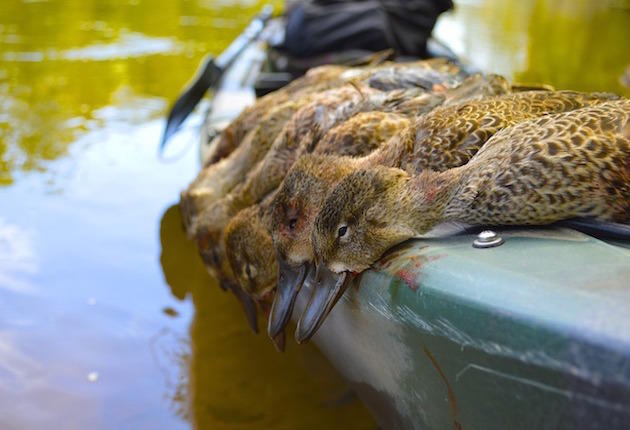The first three days of North Carolina’s 2014 early waterfowl season offered slim pickings. A single mallard hen, albeit one of the most beautiful I have ever shot, was the only duck to hit the steel wall I threw up. I half-heartedly thought of sitting out the Saturday closer, but I couldn’t pass up one more day on the water.
Good thing I didn’t, because the blue-winged teal migration made a huge push south on the last day.
The first flock of the day came just as sunrise crept over the left bank’s trees. The kayak was just outside of their overhanging canopies when five or six BWT came upstream with the air currents. It was still to early to notice colors, so I thought two unlucky wood ducks had been hit. I paddled over, scooped them up, and only then realized the mistake.
After that the teal whirled like snow geese. Thirty BWT would flush from a downed tree as I paddled by; fifty would come winging overhead. I would shoot, the birds would fly upstream, and then as if their curiousity wouldn’t let them leave without one more look, they would wheel around and come past again.
I stopped at a gravel bar to take a break, the morning sun still rising. I spread the birds I already had out for a quick photo session. I had never shot more than a single teal at a given time, and hitting the migration so well was the first chance I had to lay teal side by side … by side, by side, by side.
I worried I had shot all hens because they were all essentially the same color, with none of the distinct black, white, and blue of a drake to be seen. It would not have been illegal, but I was eager to get a drake for the taxidermist. What were the odds that I would shoot six hens out of all those swarming birds?
A little research in the Sibley bird guide cleared it up. BWT change to their winterwear one month later than green-winged teal and other ducks. They don’t reach full plumage until November, and North Carolina’s first week opener in October doesn’t allow the early migrants to color up in time.

According to the Sibley bird guide, drake blue-winged teal (left) don’t change into their winter/breeding plumage until November. (Sibley Guide to Birds)
Instead, I had to look at the legs and wings for the subtle clues.
Drake BWT have bright orange legs and bright blue feathers on the outer edges of their wings. The speculums are bright green. Hens have essentially the same colors, just darker and duller than the males.
See if you can pick out the drakes in the photos below.







